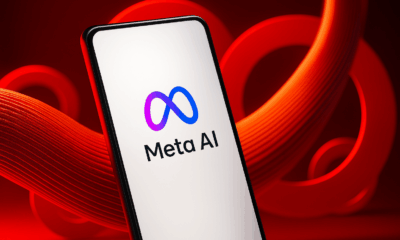News
When “Know It All” Turns Into “Know You Too Much”: Privacy Group Files GDPR Complaint Against AI Surveillance Service

- Share
- Tweet /data/web/virtuals/375883/virtual/www/domains/spaisee.com/wp-content/plugins/mvp-social-buttons/mvp-social-buttons.php on line 63
https://spaisee.com/wp-content/uploads/2025/09/gdpr.png&description=When “Know It All” Turns Into “Know You Too Much”: Privacy Group Files GDPR Complaint Against AI Surveillance Service', 'pinterestShare', 'width=750,height=350'); return false;" title="Pin This Post">
A Lithuania‑based startup is promising to track everything about you online — and then charge you to see the report. But now a European privacy watchdog is pushing back, filing a formal GDPR complaint. The case marks a fresh battleground in the struggle over personal data, AI, and who really controls our digital identities.
A Reputation Report You Didn’t Ask For
Whitebridge.ai offers “reputation reports” — dossiers compiled from social media, news articles, images, and AI‑generated inferences. Want to know what it says about you? That’ll cost you. Meanwhile, anyone else can buy the same package.
The service markets itself as a comprehensive tool: photos, personality traits, “background checks,” alerts to possible political or adult content, and suggestions for how to interact with the person profiled.
By August 2025, Whitebridge claimed to have generated roughly 560,000 reports, with around 80,000 registered users and 2.6 million people searched.
What triggered the complaint: Two individuals discovered their own dossiers in the system without having ever been alerted. When they exercised their GDPR rights — to access their data, correct it, and understand how it was collected — they faced refusals, demands for payment, and even requests for a “qualified electronic signature,” a legal quagmire many ordinary users can’t navigate.
The Legal Challenge: GDPR Violations Alleged
The nonprofit noyb (European Center for Digital Rights) filed the complaint on 29 September 2025 with Lithuania’s data protection authority.
Whitebridge claims its data processing is justified under “freedom to conduct a business” and that it draws from “publicly available sources.” But noyb argues that neither suffices as a legal basis under the GDPR.
Crucially, much of the data comes from social media accounts that aren’t indexed by web search or have privacy limitations such as friends-only visibility. Courts have already ruled that sharing within a social network doesn’t equal making that data “manifestly public.”
The complaint also highlights that in some of the purchased reports, Whitebridge flagged “sexual nudity” or “dangerous political content” about users, both of which may fall under special categories protected under Article 9 of the GDPR. Whitebridge refused to correct these “inaccurate” claims even when asked.
Under GDPR, individuals have the right to access their data free of charge, to rectify inaccuracies, and to be informed when their data is processed from third‑party sources. Whitebridge allegedly demanded payment for access requests and withheld responses unless the person provided a qualified electronic signature. It also neglected to notify the individuals that their data was being collected and shared.
Furthermore, Whitebridge’s invocation of a “disproportionate effort” excuse for not notifying data subjects runs contrary to interpretations by regulators, especially when the company is able to identify social media accounts and contact information.
In sum, noyb argues that Whitebridge may have breached a wide array of GDPR articles — including Articles 5, 6, 9, 12, 14, 15, and 16 — and seeks a declaratory ruling, orders to stop the unlawful processing, compliance with access and rectification, and sanctions.
What This Case Reveals About AI, Privacy and Reputation
This dispute sits at the intersection of three broad trends in digital life.
First, data brokering is being enhanced by AI inference. Traditional data brokers collect and resell personal information. What Whitebridge adds is a layer of AI-generated personality traits, risk scores, and behavioral warnings. That amplifies both the privacy risks and the potential for misinformation.
Second, the company’s model capitalizes on fear. Its marketing suggests users should check what information is “out there” about them — essentially monetizing curiosity or anxiety about one’s own data. The complaint contends this is exploitative, especially when users can’t legitimately access the reports without paying.
Third, GDPR enforcement is emerging as a frontier for AI oversight. As AI systems increasingly touch personal data, GDPR is becoming one of the primary legal frameworks through which privacy advocates and regulators challenge potentially harmful business models. Whitebridge may be a bellwether case for how the law adapts to AI-driven surveillance.
What Might Come Next
If Lithuania’s data protection authority finds merit in the complaint, they could force Whitebridge to comply with access and rectification requests, stop processing unlawfully gathered or inferred data, notify affected individuals about the processing, and impose fines or bans.
But beyond Whitebridge, the case may send ripples across the AI surveillance industry. Companies building user profiles from scraped data, especially when layered with AI inferences, may face more scrutiny under GDPR and similar privacy regulations.
For users concerned about their digital reputation, this case underscores the value of knowing what data exists about you — and pushing your rights under GDPR when something feels off.
AI Model
How to Prompt Nano Banana Pro: A Guide to Creating High-Quality Images with Google’s AI

Why Nano Banana Pro Matters
Nano Banana Pro is Google DeepMind’s most advanced image generation model, built on the powerful Gemini 3 Pro architecture. It delivers high-resolution outputs (up to 4K), understands complex prompts with layered context, and performs exceptionally well when generating realistic lighting, textures, and dynamic scenes. It also supports image referencing — letting you upload photos or designs to guide the visual consistency.
In short, it’s not just a toy — it’s a tool for designers, marketers, illustrators, and creatives who want to build professional-grade images fast. But to unlock its full potential, you need to learn how to prompt it properly.
Prompting Basics: Clarity Beats Cleverness
The secret to powerful results isn’t trickery — it’s clarity. Nano Banana Pro doesn’t need keyword spam or obscure syntax. It needs you to be specific and structured.
Here are the key rules to follow:
- Be descriptive, not vague: Instead of “a cat,” write something like “a ginger British shorthair cat sitting on a marble countertop under soft morning light.
- Layer your descriptions: Include details about the subject, setting, atmosphere, materials, lighting, style, and mood.
- State your format: Tell the model if you want a photo, digital painting, cinematic frame, 3D render, infographic, comic panel, etc.
- Use reference images: Nano Banana Pro supports multiple uploads — useful for matching styles, poses, faces, characters, or branding.
This is how professionals prompt: not by hacking the system, but by being precise about what they want.
Crafting Prompts by Use Case
📸 Realistic Photography
Want a product photo, fashion portrait, or cinematic still? Then your prompt should include lens type, lighting style, subject age, composition, and color grading.
Example:
Professional studio portrait of a 35-year-old woman in natural light, soft cinematic lighting, shallow depth of field, 85mm lens look, natural skin tones, soft shadows, clean background, editorial style.
Another example:
A 3/4 view of a red sports car parked in a luxury driveway at golden hour, realistic reflections, soft shadows, DSLR-style image, bokeh background.
These prompt structures help the model replicate not just the subject but the feel of a professionally shot image.
🎨 Illustration, Comic Art, and 3D Concepts
If you want stylized work — like a retro comic, anime-style character, or matte painting — the style must be part of the prompt.
Example:
Comic-style wide cinematic illustration, bold black outlines, flat vibrant colors, halftone dot shading, a heroic female astronaut on Mars with a pink sky, dramatic lighting, wide aspect ratio.
More styles to try:
- Fantasy concept art, a medieval knight riding a dragon above stormy mountains, painted in the style of Frank Frazetta, high detail, dramatic lighting.
- Cyberpunk anime character in a rain-soaked Tokyo alley, glowing neon lights, futuristic fashion, overhead perspective, digital painting.
Tip: Reference known artistic styles (e.g., Art Nouveau, Impressionism, Pixar, Studio Ghibli) to guide the tone.
🔄 Editing Existing Images
Nano Banana Pro can also transform existing images by changing backgrounds, lighting, or adding/removing objects.
Examples:
Replace the background with a rainy city street at night, reflect soft blue and orange lights on the subject, keep original pose and composition, cinematic tone.
Add a glowing book in the subject’s hands, soft magical light cast on their face, night-time indoor setting.
Best practices:
- Use clear “before/after” language.
- Indicate what must stay unchanged.
- Specify the mood or lighting effect you want added.
Common Mistakes to Avoid
- Too generic: A prompt like “a girl standing” tells the model almost nothing. Who is she? Where is she? What’s the style?
- Keyword stuffing: Don’t use outdated tricks like “masterpiece, ultra-detailed, trending on ArtStation.” They’re mostly ignored.
- Ignoring context: Don’t forget to describe how elements relate (e.g. “holding a glowing orb” vs. “glowing orb floating behind her”).
- Unclear intent for text/logos: If you want branded material, say exactly what the logo or label should look like, and where.
Prompt Templates You Can Use Right Now
Try adapting these for your needs:
- “Cinematic 4K photo of a mountain climber reaching the summit at sunrise, orange glow on snowy peaks, lens flare, dramatic sky.”
- “Retro-futuristic 3D render of a diner on Mars, neon signs, dusty surface, stars in the background, warm ambient light.”
- “Isometric vector-style infographic showing renewable energy sources, solar, wind, hydro, with icons and labels.”
- “Realistic photo of a smartwatch product on a floating glass platform, minimalistic white background, soft shadows.”
These prompts are short but rich in visual instruction — and that’s the key to strong output.
Going Further: Advanced Prompting Tips
- Use cinematic language: Words like “soft light,” “overhead shot,” “close-up,” “medium angle,” “shallow depth of field” guide the AI like a film director.
- Test with reference images: Upload an image of your brand, product, or character to maintain continuity.
- Iterate: If your first image isn’t right, adjust one or two variables (e.g., lighting, background, subject age) and regenerate.
- Define aspect ratios: Use “cinematic,” “vertical portrait,” “square crop” if you need a specific format.
- Stay natural: Write prompts like you’re briefing a professional illustrator or photographer.
Final Thoughts
Nano Banana Pro is one of the most powerful visual AI tools available — but it’s only as good as your prompts. Whether you’re an art director, a solo founder, or a content creator, learning to prompt well is the fastest way to unlock its full creative range.
Focus on clarity, visual language, and style specificity. Add references when needed. Think like a photographer, art director, or storyteller. The better your brief, the better the image.
Want more? Ask for our expanded prompt pack: 50+ ready-made formulas across categories like product design, sci-fi art, fantasy scenes, infographics, editorial portraits, and more.
AI Model
Qwen vs. ChatGPT — Which AI Assistant is Better — and For What

Why This Comparison Matters Now
Qwen, the large language model developed by Alibaba Cloud, has recently been gaining significant attention. The release of Qwen 2.5-Max and its successors has sparked comparisons across benchmarks covering reasoning, coding, long-context handling, and multimodal tasks. Meanwhile, ChatGPT continues to dominate as the default choice for many users who prioritize conversational quality, creative tasks, and ease of use. Comparing the two is increasingly important for anyone deciding where to invest their time, money, or infrastructure in 2025.
Let’s explore how Qwen and ChatGPT compare across major performance categories — and which model might suit your needs better.
Where Qwen Shines: Power, Context, and Flexibility
One of Qwen’s strongest features is its ability to handle long-context reasoning and document-heavy workflows. With larger context windows than many competitors, Qwen is particularly adept at analyzing long reports, writing consistent long-form content, summarizing legal or technical material, and managing multi-layered input without losing coherence. It’s a powerful tool for users who need depth.
Qwen also excels in structured logic and code-related tasks. In independent evaluations, it has shown impressive results in mathematical reasoning, data extraction, and code generation. For developers and technical users looking for an AI assistant to support real engineering workflows — rather than simply explain code snippets — Qwen is a highly capable alternative to established incumbents.
Multimodal and multilingual flexibility is another area where Qwen stands out. It supports text, image input, and multiple languages, enabling it to serve as a true assistant across varied communication and media formats. That’s particularly useful for global users or teams operating in bilingual or multilingual environments.
Finally, the open-source accessibility of Qwen is a major advantage. While not every version is fully open, many variants are freely available and can be run locally or fine-tuned. For users prioritizing data control, customization, or cost-efficiency, that’s a serious point in Qwen’s favor.
Where ChatGPT Excels: Conversation, Creativity, and Ecosystem
ChatGPT continues to lead when it comes to polish and user experience. Its conversational flow is smooth, stylistically natural, and often feels more human than any other model on the market. That’s invaluable for creative writing, ideation, storytelling, or any application that requires tone, style, and nuance. It’s also why many casual users prefer ChatGPT over more technical models.
ChatGPT’s integration with live data, APIs, and tools (depending on the version) provides a dynamic and extensible platform for users who need real-time insights or app-level functionality. If you’re looking for an assistant that can browse the web, generate code, search documentation, or plug into third-party services, ChatGPT is often the more mature choice.
Consistency, reliability, and safety mechanisms also remain a strength. For teams or individuals who don’t want to think about model drift, hallucination tuning, or backend parameters, ChatGPT offers a plug-and-play solution that’s hard to beat. It’s a tool that just works — and that simplicity matters more than benchmark scores for a wide audience.
The scale and maturity of ChatGPT’s ecosystem also give it a clear edge. From community guides to business integrations, apps, and workflows — it’s supported nearly everywhere, and that makes it easy to adopt regardless of your skill level.
Limitations and Trade-offs
That said, Qwen and ChatGPT each come with their own trade-offs.
Qwen, while powerful, sometimes lacks the fluency or stylistic finesse that makes ChatGPT feel so natural. It can hallucinate in edge cases, and while some versions are open-source, the most powerful iterations may still depend on Alibaba’s infrastructure, limiting portability for privacy-centric users.
ChatGPT, for its part, is a closed model, with cost barriers and fewer customization options. It also has a more constrained context window in some versions, making it less ideal for ultra-long documents or advanced reasoning across large data structures.
Which Model Should You Use?
If your work involves processing long documents, building tools, working with code, or requiring multilingual support — and you value the ability to run models locally or integrate them deeply — Qwen is an excellent fit. Its performance is strong, and it offers more technical freedom for advanced users.
If your needs are creative, conversational, or content-driven — and you want something intuitive, responsive, and polished out of the box — ChatGPT is still the best experience available today. It’s perfect for brainstorming, writing, email generation, and any task where clarity, creativity, and tone matter.
For enterprise teams, researchers, and power users — using both might be the optimal solution. Qwen can handle the heavy lifting in development and data, while ChatGPT takes care of interaction, presentation, and ideation.
Final Verdict
There’s no absolute winner in the Qwen vs. ChatGPT debate — only better fits for different tasks. Qwen brings muscle, flexibility, and context awareness. ChatGPT delivers fluency, elegance, and seamless usability.
In the AI race of 2025, the smartest move isn’t to pick a side — it’s to pick the right tool for the job.
News
Alibaba’s AI Coup: Qwen App Hits 10 Million Downloads in One Week — And the AI Wars Just Escalated

A Meteoric Debut for Qwen
Alibaba’s freshly launched Qwen app has crossed 10 million downloads in just its first seven days — a staggering adoption rate that places it among the fastest-growing AI applications globally. The explosive start signals more than consumer interest. It marks Alibaba’s transition from infrastructure giant to serious AI contender in the public arena.
Qwen Isn’t Just Another Chatbot
At the core of Qwen’s early success is its engine: the Qwen model family, developed in-house by Alibaba. These large language models (LLMs) are multimodal — capable of processing not just text, but also images, audio, and potentially video. Unlike other AI tools that remain sandboxed in niche applications, Qwen is designed as a true all-in-one assistant.
From drafting documents and summarizing reports to answering questions and managing multimedia tasks, Qwen is built to be useful — not just entertaining. And critically, it launched with a free-access model, eliminating the subscription paywall that often hinders adoption in early-stage AI apps.
From E-Commerce to Everyday AI
This launch represents a clear strategic pivot for Alibaba. Historically known for e-commerce dominance and its powerful cloud infrastructure (via Alibaba Cloud), the company is now positioning itself as a top-tier player in the AI space — not just at the backend, but at the consumer-facing layer.
Qwen is not just a product — it’s a platform play. It ties into Alibaba’s cloud resources, shopping ecosystem, productivity tools, and eventually, financial services. By releasing it as a standalone, viral consumer app, Alibaba is laying the groundwork for a much bigger AI ecosystem play.
Global AI Ambitions, Starting in Asia
While Qwen’s initial rollout is concentrated in China and Southeast Asia, there are clear signs Alibaba intends to push the app globally. With Western alternatives like ChatGPT, Claude, and Gemini facing geopolitical and regulatory barriers in some regions, Qwen could capitalize on being both regionally accessible and locally optimized.
Additionally, the app’s early traction reflects strong demand for AI solutions tailored to regional languages, customs, and ecosystems. As Chinese tech continues to look outward, Qwen may become a cultural as well as a technological export — one capable of competing head-to-head with the biggest names in global AI.
The Next Phase: Monetization and Market Power
Crossing 10 million downloads in a week is only the first milestone. The real test lies in retention, monetization, and integration. Alibaba will now focus on converting casual users into power users, offering advanced features, integrating payments, cloud-based services, and potentially leveraging the app to strengthen its broader commercial footprint.
There is already speculation that Qwen could evolve into the “WeChat of AI” — a super-assistant that combines messaging, productivity, shopping, and finance in a single intelligent interface. If that vision materializes, Alibaba may have just positioned itself as the most powerful AI consumer company outside the West.
Final Thought
The Qwen launch is not just about downloads. It’s about direction. Alibaba has made its move — not with hype or vague roadmaps, but with a working, useful, and widely adopted AI assistant. The global AI race is officially more competitive than ever.
-

 AI Model2 months ago
AI Model2 months agoHow to Use Sora 2: The Complete Guide to Text‑to‑Video Magic
-

 AI Model4 months ago
AI Model4 months agoTutorial: How to Enable and Use ChatGPT’s New Agent Functionality and Create Reusable Prompts
-

 AI Model5 months ago
AI Model5 months agoComplete Guide to AI Image Generation Using DALL·E 3
-

 AI Model5 months ago
AI Model5 months agoMastering Visual Storytelling with DALL·E 3: A Professional Guide to Advanced Image Generation
-

 AI Model3 months ago
AI Model3 months agoTutorial: Mastering Painting Images with Grok Imagine
-

 News2 months ago
News2 months agoOpenAI’s Bold Bet: A TikTok‑Style App with Sora 2 at Its Core
-

 AI Model7 months ago
AI Model7 months agoGrok: DeepSearch vs. Think Mode – When to Use Each
-

 Tutorial2 months ago
Tutorial2 months agoFrom Assistant to Agent: How to Use ChatGPT Agent Mode, Step by Step











